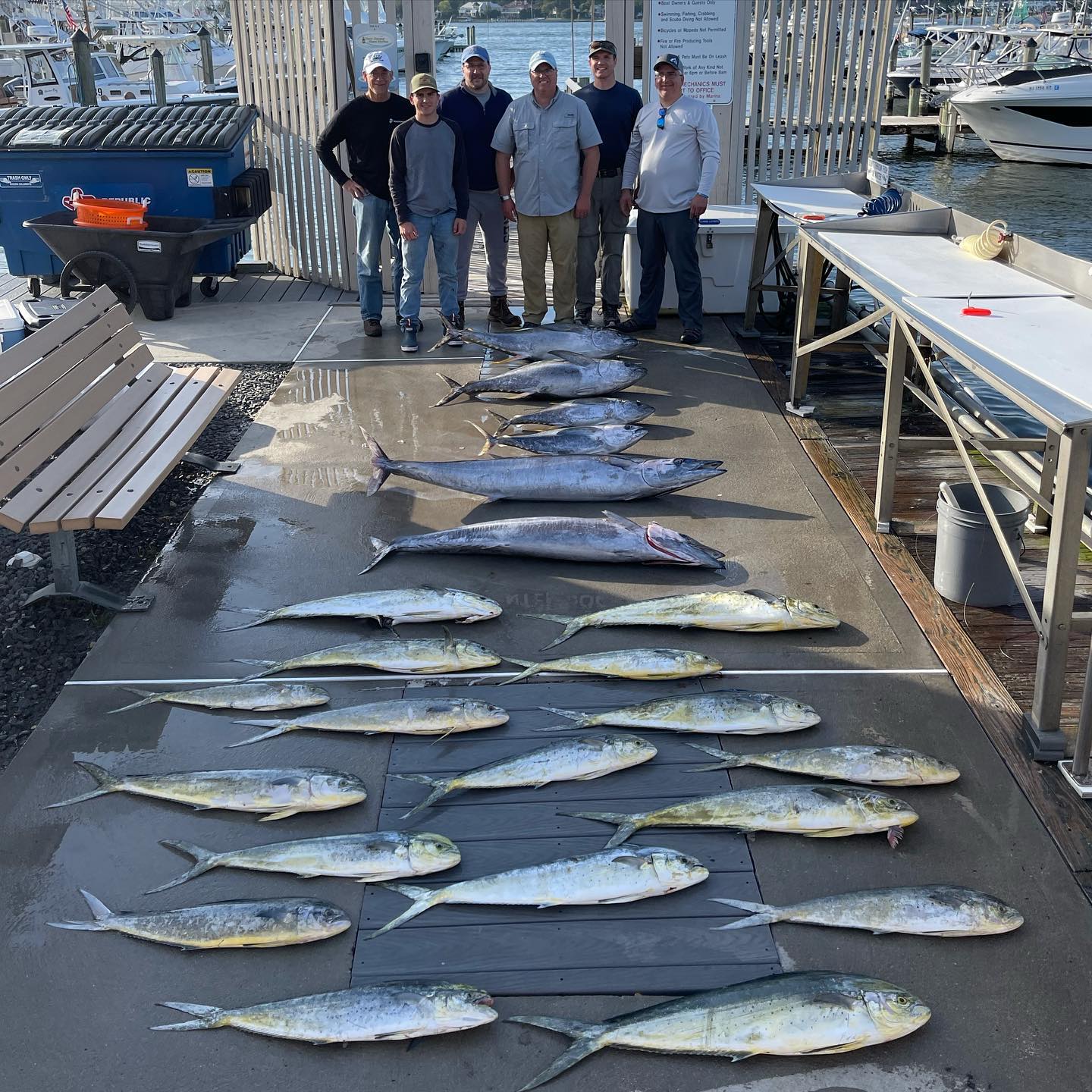
Yellowfin Tuna
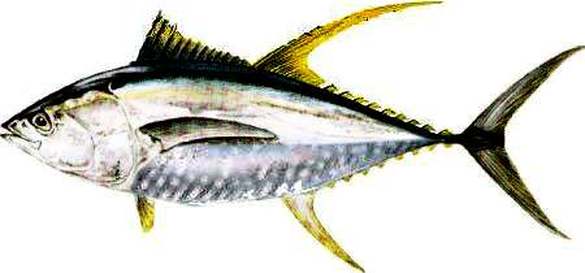
Yellowfin Tuna
Also known as Allison Tuna and Ahi (Hawaii) The caudal fin of the yellowfin tuna is distinctly notched in an “M” chape at the centre of its fork. Behind the seconddorsal fin and the anal fin, the body profile of the yellowfin tuna is somewhat flat. The ventral surface of the liver is smooth and the right lobe is longer than the central lobe.
Yellowfin tuna adults are distinguished by having a moderately long pectoral fin that is one third to one quarter the body fork length. In juveniles there are about 20 broken pale lines crossing the lower sides. In large fish, the second dorsal and anal fins may be exceedingly elongated and bright yellow. Yellowfin tuna less than 75cm fork length (10kg whole weight) may be difficult to distinguish from small bigeye tuna.
A beautiful and colourful tuna. Blue to steel black above, silver to silvery gold on the flanks, silvery white below. In fresh fish a band of bright gold or iridescent blue (sometimes both) runs along the upper flank, separating the dark back from the lighter belly area.
The stomach area sometimes carries oval, colourless patches and vague broken vertical bars of white. These are more obvious in juveniles. The yellowfins fins are bright yellow. The finlets, in particular are canary yellow with black margins.
Yellowfin tunas are one of the most abundant fish found in the Northern Canyons that we call home off of New Jersey which include Block, The Dip, Hudson, Toms, Carteret, Lindencole, Spencer, Wilmington, Baltimore, Poormans, and Washington Canyons. These fish travel in large schools and are often caught in great numbers. When trolling, multiple hook ups from 3 to 10 fish are the rule rather than the exception.
Peak periods for yellowfin tuna are May through November. Yellowfin tunas range in size from 15 to 225 lbs off of the New Jersey Coast and we usually encounter the first yellowfin of the season on the troll in May. These fish primarily range from 25-60 pounds. By the middle of August, the yellow settle in and we begin chunking at night and usually find the majority of our quarry ranging from 40-80 pounds.
The largest Yellowfin to date on the Canyon Runner weighed in at 237 pounds. The most Yellowfin caught (with many released) in one trip – 72 Chunking and 52 Trolling.
Big-Eye Tuna
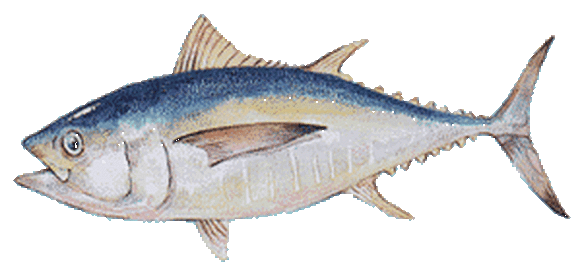
Big-Eye Tuna
Bigeye Tuna have a shallow notch at the centre of the caudal fin fork and, in adults, the eye is relatively large compared with that of other tunas. Their entire dorsal and ventral body profiles are evenly curved. The liver has noticeable striations and its central lobe is the longest. The pectoral fin in adult bigeye tuna is one-quarter to one-third the body fork length, whereas the pectoral fin in juvenile bigeye tuna is longer and always extends beyond a line drawn between the anterior edges of the second dorsal and anal fins. Bigeye tuna less than 75cm fork length (10kg whole weight) hwave longer pectoral fins than Yellowfin Tuna of comparable sizes. Juvenile bigeye tuna often have 7-10 white unbroken stripes crossing the lower sides vertically, substantially fewer than in juvenile yellowfin tuna.
Bigeye tuna are found in tropical and subtropical waters of the Pacific, Indian and Atlantic oceans. They are an oceanic fish. Although juvenile bigeye tuna have not been reported outside tropical waters.
Bigeye tuna smaller than 20kg are mainly found with surface-dewlling schools of similar fish such as yellowfin tuna and skipjack tuna. Larger bigeye over 100 pounds usualy travel in schools of only bigeye tuna are less common.
Big-eye tunas are one of the most sought after tuna found in the Northern Canyons Pound for pound they are the hardest fighting fish in the Ocean. While extremely sought after, these fish are not often caught. When they do show up, however, they show up in wolf-packs that clobber your lures and empty your reels. Trolling early in the morning or at dusk is hands down the most productive when to hunt this quarry. Once raised to the pattern if you keep the boat moving expect 3 or 4 to hang around to battle it out.
The Big-Eyes we usually encounter in the Northern Canyons average in weight from 125 to 225 pounds with fish over 300 not unheard of. There numbers in the late 1990s through late 2000s dwindled considerably. However, starting in 2011 we started to see a comeback in there numbers and in 2013 we saw a huge increase in catches with over 100 big-eyes caught that year. 2014 was a decent season and then came 2015 when all records were blown out of the water when the Canyon Runner boats boated 149 big-eyes and Capt. Deane Lambros accounted for 79 on his own.
The largest Big-eye to date on the Canyon Runner weighed in at 307 pounds. The most Big-Eyes caught in one trip = 8.
Bluefin Tuna

Bluefin Tuna
Common Names: Giants
W. Atlantic Range: Newfoundland to the Bahamas
The Bluefin Tuna is one of the largest and most highly prized marine gamefishes. Giants of the species are know to exceed 1,500 lbs., and the high quality of the meat can push the value of some fish to tens of thousands of dollars by overseas buyers.
The Bluefin has more gillrakers than any other species, with 31-43 on the first arch. The liver is striated.
The giants of the species can be found off of the Carolinas during the winter and early spring, and migrate north of Gloucester in the summer time. Off the New Jersey Coast, we usually get a shot at the Giants in late May and early June. However, a few years back the only place to be to fish for Giants in September and October was the Mudhole. Unfortunately, the Giants have not made an appearance off of New Jersey in years and we have not fished for them since the early 1990’s.
We target Giant Bluefin tuna every winter off the coast of North Carolina with trolling, chunking and green sticking all producing well. We’ve had days where we caught over a dozen bluefin over 300 pounds – some of them on jigging and popping light tackle – nothing comes close to hook, fighting and darting one of these beasts.
The largest Giant Bluefin attributable to a Canyon Runner crew member weighed in at 1058 pounds with Capt. Dulanie crewing the capture of two of these Granders in one day of 1058 & 1029 lbs.
Albacore
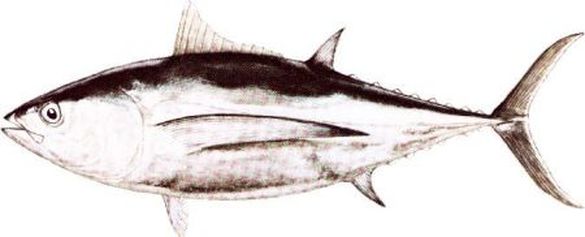
Albacore
Common Names: Longfin
The Albacore is easily distinguished from other species of tuna by its long pectoral fin, often extending past its second dorsal fin.
Albacore are know as the “chicken of the sea” because of their high quality white meat. Most canned tuna fish sold in stores today is Albacore.
Like most tunas, they can be caught by either trolling artificial and live baits, or by chunking. However, 95% of the Longfin caught in Northeast Canyons are caught on the troll. Small jets and ballyhoo produced the best.
The Longfin usually make their first appearance of the year in the Toms Canyon in mid to late July and when they show, they show strong. Trolling for Longfin requires some self control as when the first fish hits never, never slow down the boat. A typical barrage of Albacore should produce 3-4 fish on at a time. On the Canyon Runner ever year we typical have 4-5 baggers on most trips and produce several 7 baggers a year.
There is nothing better then when you have been trolling for hours with out a touch and as noon approaches and the boxes are empty you are loaded up with Longfin. You put 7 in the boat in under 10 minutes from initial hook-up to the last gaff being thrown. You get the lines back out in under a minute. Turn around. Troll over the numbers. Load up again with 5 more. Gaff and bleed number 5 again in under 10 minutes and in just 20 minutes you went from being shut-out to boxes loaded with a dozen 30-50 pound Albacore. This sceanario has played out on the Canyon Runner on numerous occasions.
The most Longfin to date on the Canyon Runner was posted during the 2000 season as 45 were boated, with many released, in one day in July. The most Longfin caught at once was a 9 for 9 bagger on that very trip. Most impressive was that there were only two anglers and two mates in the cockpit.
Blue Marlin
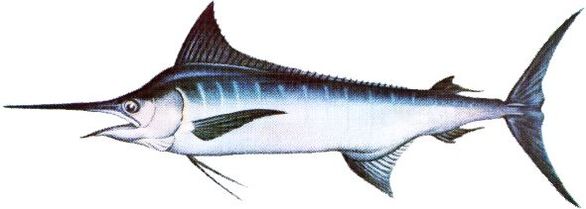
Blue Marlin
Common Names: makaira
W. Atlantic Range: Cape Cod to the Virgin Islands
The Blue Marlin, or “makaira” as it is often called, is the grand prize for many offshore anglers. Its great size and tremendous fight when hooked are a challenge to the most accomplished angler.
The Blue Marlin usually encounter in the Northern Canyons average on the larger size in weight from 400 to 600 pounds with fish over 700 pounds not unheard of. There numbers in recent years has seemed to increase, at least from our experience. We have raised over 15 Blue Marlin in the last 3 years and released 8.
The largest Blue Marlin to date on the Canyon Runner was estimated to weigh over 600 pounds. The Canyon Runner highlighted the 2000 canyon season by releasing 3 Blue Marlin in one week of 200, 400, & 600 pounds respectively.
White Marlin

Blue Marlin
W. Atlantic Range: Nova Scotia to Brazil
White Marlin are one of the few billfish species confined to the Atlantic ocean. Its distinguishing characteristic is its rounded dorsal and anal fins, as opposed to the sharply pointed fins of related species.
The White Marlin commonly displays a more greenish coloration than any other marlin. White Marlin do not attain great size, averaging 50 – 60 pounds. They are an excellent light tackle challenge and are fairly abundant from Ocean City, Maryland to Montauk, NY in the summer months.
White Marlin are usually encounter in the Northern Canyons during July and early August with better catches coming from the Southern Canyons (i.e., Wilmington, Baltimore, Norfolk, etc.). There numbers in recent years has seemed to increase, at least from our experience, except for the most recent when we did not raise one White Marlin in 49 canyon trips. Hopefully this is not a sign for bad times to come. In fact, in 1999 we had a banner year with Whites considering we do most of our fishing in the Hudson Canyon (not exactly White Marlin country) raising over 20 and releasing 14.
The largest White Marlin to date on the Canyon Runner weighed in at 64 pounds and won $80,000 at the Mid-Atlantic $500,000 Tournament.
Swordfish
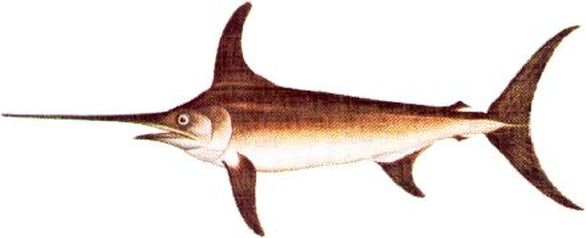
Swordfish
Common Names: broadbill, broadbill swordfish
W. Atlantic Range: From New England south
Swordfish are an important species to both sport and commercial fishermen. The Swordfish is easily identified by it’s long, flat sword, generally much longer than its head. Also noticeable is the absence of pelvic fins and the abscence of scales in adults.
Swordfish are prized table fare for their firm, white meat. They are a deep water species, targeted by Northeastern anglers on offshore trips. Best fishing occurs after sundown, using large, whole squid for bait with a light stick.
The largest swordfish to date on the Canyon Runner weighed in at 175 lbs but the most remarkable catch occurred in 2003 in the Lindencohl Canyon as we went 4 for 6 on swordies in one night.
